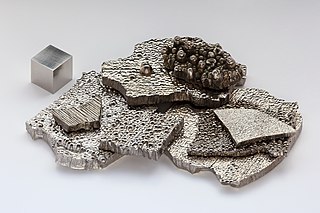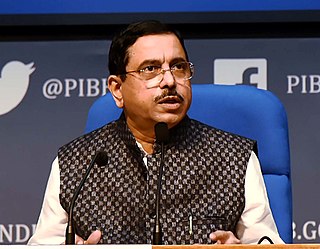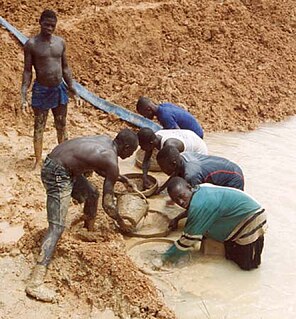Related Research Articles

Mining is the extraction of valuable minerals or other geological materials from the Earth, usually from an ore body, lode, vein, seam, reef, or placer deposit. Exploitation of these deposits for raw material is based on the economic viability of investing in the equipment, labor, and energy required to extract, refine and transport the materials found at the mine to manufacturers who can use the material.

Coltan is a dull black metallic ore from which the elements niobium and tantalum are extracted. The niobium-dominant mineral in coltan is columbite, and the tantalum-dominant mineral is the tantalite.

The University of Queensland is a public research university located primarily in Brisbane, the capital city of the Australian state of Queensland. Founded in 1909 by the Queensland parliament, UQ is one of the six sandstone universities, an informal designation of the oldest university in each state. The University of Queensland was ranked second nationally by the Australian Research Council in their latest research assessment and equal second in Australia based on the average of four major global university league tables. The University of Queensland is a founding member of edX, Australia's leading Group of Eight and the international research-intensive Association of Pacific Rim Universities.

The Australian Antarctic Territory (AAT) is a part of East Antarctica administered by the Australian Antarctic Division, an agency of the federal Department of Agriculture, Water, and the Environment. The territory's history dates to a claim on Enderby Land made by the United Kingdom in 1841, which was subsequently expanded and eventually transferred to Australia in 1933. It is the largest territory of Antarctica claimed by any nation by area. In 1961, the Antarctic Treaty came into force. Article 4 deals with territorial claims, and although it does not renounce or diminish any pre-existing claims to sovereignty, it also does not prejudice the position of Contracting Parties in their recognition or non-recognition of territorial sovereignty. As a result, only four other countries—New Zealand, the United Kingdom, France, and Norway—recognise Australia's claim to sovereignty in Antarctica.

Rio Tinto Group is an Anglo-Australian multinational and the world's second-largest metals and mining corporation, behind BHP, producing iron ore, copper, diamonds, gold and uranium. The company was founded in 1873, when a multinational consortium of investors purchased a mine complex on the Rio Tinto, in Huelva, Spain, from the Spanish government. Since then, the company has grown through a long series of mergers and acquisitions to place itself among the world leaders in the production of many commodities, including aluminium, iron ore, copper, uranium and diamonds. Although primarily focused on extraction of minerals, Rio Tinto also has significant operations in refining, particularly for refining bauxite and iron ore. Rio Tinto has joint head offices in London and Melbourne.

Mining in Australia has long been a significant primary sector industry and contributor to the Australian economy by providing export income, royalty payments and employment. Historically, mining booms have also encouraged population growth via immigration to Australia, particularly the gold rushes of the 1850s. Many different ores, gems and minerals have been mined in the past and a wide variety are still mined throughout the country.

Mining in Western Australia, together with the petroleum industry in the state, accounted for 94% of the State's and 46% of Australia's income from total merchandise exports in 2019–20. The state of Western Australia hosted 123 predominantly higher value and export-oriented mining projects and hundreds of smaller quarries and mines. The principal projects produced more than 99 per cent of the industry's total sales value.

The mining industry of the Democratic Republic of the Congo plays a significant role in the world's supply of cobalt, copper, diamond, tantalum, tin, gold and produces over 70% of globally produced cobalt. It is the Democratic Republic of the Congo's largest source of export income.

Environmental impact of the oil shale industry includes the consideration of issues such as land use, waste management, and water and air pollution caused by the extraction and processing of oil shale. Surface mining of oil shale deposits causes the usual environmental impacts of open-pit mining. In addition, the combustion and thermal processing generate waste material, which must be disposed of, and harmful atmospheric emissions, including carbon dioxide, a major greenhouse gas. Experimental in-situ conversion processes and carbon capture and storage technologies may reduce some of these concerns in future, but may raise others, such as the pollution of groundwater.

Nuclear weapons testing, uranium mining and export, and nuclear power have often been the subject of public debate in Australia, and the anti-nuclear movement in Australia has a long history. Its origins date back to the 1972–73 debate over French nuclear testing in the Pacific and the 1976–77 debate about uranium mining in Australia.

The Ministry of Mines, a branch of the Government of India, is the apex body for formulation and administration of the rules and regulations and laws relating to mines in India. The head of the ministry is Pralhad Joshi since June 2019.

Mining is the biggest contributor to Namibia's economy in terms of revenue. It accounts for 25% of the country's income. Its contribution to the gross domestic product is also very important and makes it one of the largest economic sectors of the country. Namibia produces diamonds, uranium, copper, magnesium, zinc, silver, gold, lead, semi-precious stones and industrial minerals. The majority of revenue comes from diamond mining. In 2014, Namibia was the fourth-largest exporter of non-fuel minerals in Africa.

Mining in New Zealand began when the Māori quarried rock such as argillite in times prior to European colonisation. Mining by Europeans began in the latter half of the 19th century.

The Telfer Mine is a gold, copper and silver mine located at Telfer on the land of the Martu people, in the Great Sandy Desert of Western Australia. It is owned by Newcrest Mining, the greatest gold producer listed on the Australian Securities Exchange.
Peak minerals marks the point in time when the largest production of a mineral will occur in an area, with production declining in subsequent years. While most mineral resources will not be exhausted in the near future, global extraction and production is becoming more challenging. Miners have found ways over time to extract deeper and lower grade ores with lower production costs. More than anything else, declining average ore grades are indicative of ongoing technological shifts that have enabled inclusion of more 'complex' processing – in social and environmental terms as well as economic – and structural changes in the minerals exploration industry and these have been accompanied by significant increases in identified Mineral Reserves.

The mining industry of Sierra Leone accounted for 4.5 percent of the country's GDP in 2007 and minerals made up 79 percent of total export revenue with diamonds accounting for 46 percent of export revenue in 2008. The main minerals mined in Sierra Leone are diamonds, rutile, bauxite, gold, iron and limonite.

The Olympic Dam mine is a large poly-metallic underground mine located in South Australia, 550 km (341.75 mi) NNW of Adelaide. It is the fourth largest copper deposit and the largest known single deposit of uranium in the world. Copper is the largest contributor to total revenue, accounting for approximately 70% of the mine's revenue, with the remaining 25% from uranium, and around 5% from silver and gold. BHP has owned and operated the mine since 2005. The mine was previously owned by Western Mining Corporation.
The Institute for Mineral & Energy Resources (IMER) is the point of contact at the University of Adelaide for strategic research interests related to mineral and energy resources. It was founded in 2009 and launched h Australian Minister for Mineral Resource Development, Paul Holloway on 5 October 2010. The institute attracted over $18.5 million in research funding and corporate sponsorship in its first year. The IMER facilitates collaborative research between the higher education sector and industry and can take the shape of project collaboration to meet a company's specific needs, consultancy utilising academic researchers and PhD students, organisational collaboration to leverage government funding and long-term partnerships offering mutual benefits.

The mining industry of Liberia has witnessed a revival after the civil war which ended in 2003. Gold, diamonds, and iron ore form the core minerals of the mining sector with a new Mineral Development Policy and Mining Code being put in place to attract foreign investments. In 2013, the mineral sector accounted for 11% of GDP in the country and the World Bank has projected a further increase in the sector by 2017.

The mining industry of South Sudan started operating from the time South Sudan became a regional government of Sudan in 2005. Its inheritance was a well developed petroleum industry with an extensive network of pipelines passing through Sudan. However, contractual allotments in mining lacked any form of regulatory framework, resulting in the legislative assembly imposing a moratorium on mining licenses in November 2010. With independence in 2011, the petroleum industry was halted. Subsequent to this event, interest in mining non-fuel minerals has emerged and a new Mining Act has come into effect from December 2012.
References
- ↑ "Beware of Sea-Bed Mining: NGO". The Fiji Times. 13 June 2008. Retrieved 19 June 2008.
- ↑ "History of MPI". Mineral Policy Institute. 13 April 2005. Archived from the original on 20 July 2008. Retrieved 19 June 2008.
- ↑ "Australia, South Africa Breach Waste Dumping Ban". Green Left Online. 20 September 2000. Archived from the original on 29 November 2012. Retrieved 19 June 2008.
